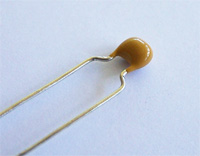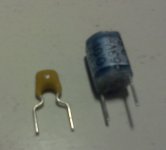Someone tested Obbligatos for C13 ?
Sure, they were part of the Ultimate GB.
They sound pretty good but other caps are better.
Which cap is?
A plain X7R ceramic...
I'm not too surprised - I posted a while ago that a C0G ceramic works fine at C7 - IIRC, I tried a 27nF AVX or Kemet. If an X7R works, then most probably an SMD PPS cap like Panasonic ECH-U will also work there.
O.K. you guys, I think I found the right isle in the library. Others my also find it helpful to get through the maze. CapSite 2009
A lot of catching up to do!!!!
A lot of catching up to do!!!!
Last edited:
Some news of the day after...
I confirm that they are less colored than almost all film caps (apart polystirene maybe) but they simplify somewhat the harmonics content.
They're not dry but the sound with no C7 is richer...
And some film caps, while more colored, preserve that richness.
Sorry, the quest continues...
Edit:
Yesterday I've made the listening test with all FKP2s for C30,C32, C34, today I've used the more transparent Amtrans AMCHs.
So probably the FKP2s masked that difference.
- different brands sound different
- AVX sound quite good
I confirm that they are less colored than almost all film caps (apart polystirene maybe) but they simplify somewhat the harmonics content.
They're not dry but the sound with no C7 is richer...
And some film caps, while more colored, preserve that richness.
Sorry, the quest continues...
Edit:
Yesterday I've made the listening test with all FKP2s for C30,C32, C34, today I've used the more transparent Amtrans AMCHs.
So probably the FKP2s masked that difference.
Last edited:
hehe at least the road is narrowing down. join the dark side, dario. the background is most black here >:]
The Force will guide me, I'll never join the Dark Side, Darth Presapian!
well I got my system
howdie!

I got my speakers built, chip amps wired,DCX 2496 ect ect,and had them cranked up adjusting it all ,6 chip amps LMH, subs not ready yet,lol.
I was listening to Stevie ray V.and noticed the bass had my leds flickering on the bass amps with the bass notes ,it still was sounding great but now next thing to do? add more caps or a bigger trans former ,at 160 watts a chanel maybe a bigger amp?I have 2 @ 350 watts 4 chip for the sub looks like it's getting bumped,lol.

Never had the pleasure to change crossover points on the fly but it's real nice and you can adjust it where it sounds just right either by the freq or the power of the amp YEA!
howdie!
I got my speakers built, chip amps wired,DCX 2496 ect ect,and had them cranked up adjusting it all ,6 chip amps LMH, subs not ready yet,lol.
I was listening to Stevie ray V.and noticed the bass had my leds flickering on the bass amps with the bass notes ,it still was sounding great but now next thing to do? add more caps or a bigger trans former ,at 160 watts a chanel maybe a bigger amp?I have 2 @ 350 watts 4 chip for the sub looks like it's getting bumped,lol.
Never had the pleasure to change crossover points on the fly but it's real nice and you can adjust it where it sounds just right either by the freq or the power of the amp YEA!
right, but you said that ceramics were more musical than the ero stryene type. i'm just trying to fogure out what the poly cap was lacking in comparison and also if theyll be any drawback all in replacing most fkp2s with them. its really hard to a/b with the polystyrene caps necause once you try to desolder them.. poof, theyre liquified 
right, but you said that ceramics were more musical than the ero stryene type.
At the moment I've found the ceramic to sound simply right: balanced, detailed, not harsh.
But I didn't noticed that they were simplifying somewhat the harmonic content.
I must thank Suburra that pointed my attention on that parameter.
My personal quest is over with NOS KP1834 polystirenes, they're simply the best (among caps I've tried) in C7 and NOS film/foil polycarbonates are nice alternatives.
But all of them are becoming harder to find any day more since they're out of production from years.
I'm searching an available cap for who will build the FE.
KP1830 is so far the best bet but I'm not sure it's as rich as the KP1834.
i'm just trying to fogure out what the poly cap was lacking in comparison and also if theyll be any drawback all in replacing most fkp2s with them.
You should try Amtrans AMCH, they seem very good, much more refined than FKP2s... they seem to approach (but not reach) polystirenes.
At least so far, I'm still evaluating them.
its really hard to a/b with the polystyrene caps necause once you try to desolder them.. poof, theyre liquified
Not at all if you use sockets, in fact is the only way to try without distructing them...
Probably too much inductance resulting in decoupling that can't do it's job !
It's possible.. ceramics TH have longer leads than most film caps:

But I think that also the steel leads could have a part on it.
Evox PFR (polypropilene film/foil with steel leads) also sounded less rich than other film/foils.
I felt inclined to post an expletive or several !!!!.......It's possible.. ceramics TH have longer leads than most film caps:

Trim off all the excess lead, just like you do with other leaded components.
Attach the 1.5mm of remaining lead directly to the respective Power PINs of the chip and get the attachment right next to the package, not some 5m or 10mm away, on the traces soldered to the far ends of the Power PINs.
The decoupling must have the absolute shortest circuit route to be effective.
Miss this critical requirement and you will be introducing all kinds of misbehaviour into the way the chip processes the signal.
I really do feel that all your guesswork has taken you down a path that has nothing to do with designing an amplifier to process signals correctly.
I have been saying this for months, or is it years, and you have not taken the hint. Why do I have to be blunt? Will you ever listen to advice?
Now I return to a bit of advice that is scattered throughout this Forum and others.
Attach properly implemented decoupling from Rail to Ground for both polarities of Power PINs and give the amplifier a chance to behave properly when processing signal. That means HF decoupling at the package, MF decoupling at the traces near the PINs and LF decoupling where it can be fitted on the PCB.
Then you might find that C7 is actually not required. Then you might also find that all the experiments with various other caps show no changes in sound quality/non quality.
Last edited:
I have been saying this for months, or is it years, and you have not taken the hint. Why do I have to be blunt? Will you ever listen to advice?
Andrew,
you can find attached the actual caps I'm using near to the KP1834.
As you can see leads have been trimmed.
The picure in the previous post is a generic one I've found on the internet...
Attachments
Now I return to a bit of advice that is scattered throughout this Forum and others.
(...)
Then you might find that C7 is actually not required. Then you might also find that all the experiments with various other caps show no changes in sound quality/non quality.
I've just seen your edit.
Interesting, thanks for the info, I'll try also that.
Still far too long. Absolute minimum means really short.
You're right Andrew, they're so to use them on sockets.
When soldered and correctly trimmed all those caps will be (possibly far) more effective as bypass.
In this phase I'm not evaluating their effectiveness as bypass but the effect they have on sound.
I've also soldered and trimmed some of caps in test and their sonic signature remained consistent with the one I've heard when socketed.
I understand you're saying that when correctly trimmed and soldered on pads as near as possible to power pins probably their signature will be (much) less evident but in my tests it was not so.
Last edited:
- Home
- Amplifiers
- Chip Amps
- My "audiophile" LM3886 approach
